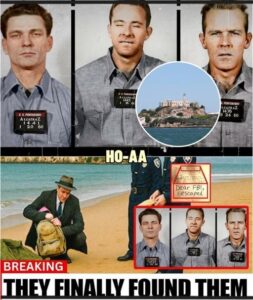The Alcatraz Enigma Finally Solved: After More Than Half a Century, the Truth Surfaces

The night was cold, still, and cloaked in fog—perfect conditions for a desperate escape. Three prisoners, hardened by years behind bars, slipped through the darkness of America’s most feared penitentiary and into legend. What followed became one of the greatest mysteries in criminal history.
For over fifty years, the disappearance of Frank Morris and the Anglin brothers baffled investigators, captivated the public, and inspired countless books and Hollywood films. But now, new evidence has emerged—evidence that may finally reveal what really happened that fateful night in 1962.
The Fortress No One Could Escape
Perched on a rocky island amid the icy waters of San Francisco Bay, Alcatraz was built to crush the human spirit. Its very isolation was its strength—strong currents, bone-chilling temperatures, and deadly tides made the surrounding sea an almost certain death trap.
During its 29 years as a federal prison, 36 men dared to flee. Nearly all were caught or killed. Yet none captured the world’s imagination like the trio who vanished without a trace one June night.
The Ingenious Plot That Fooled the Guards
Frank Morris—sharp, disciplined, and resourceful—teamed up with John and Clarence Anglin, two brothers with a long history of bank robberies. Along with a fourth inmate, Allen West, they spent months quietly engineering their escape.
Armed with little more than spoons, bits of scrap metal, and a homemade drill cobbled together from a vacuum cleaner motor, they chipped away at the walls behind their cells. Each night, they concealed their work with painted cardboard panels.
To avoid suspicion during roll call, they crafted incredibly realistic dummy heads out of soap, toilet paper, and hair collected from the prison barbershop. Their most daring invention, though, was a makeshift raft sewn together from over 50 stolen raincoats.
On the night of June 11, 1962, the plan came alive. The men crawled through the holes they had dug, climbed onto the roof, and slipped down to the water. Then, using their handmade raft, they paddled away into the freezing bay.
By morning, guards discovered the decoys and raised the alarm. The escape was flawless—but the men were gone. Only fragments of their raft were later found floating near Angel Island.
Authorities declared they must have drowned. But not everyone was convinced.
The Investigation That Never Truly Ended
The FBI launched a nationwide manhunt—the largest of its time. Helicopters scoured the bay, Coast Guard boats cut through the waves, and agents monitored the fugitives’ families for years. But not a single confirmed trace of the men was ever found.
In 1979, the FBI officially closed the case, insisting the escapees perished in the water. Still, rumors persisted—letters, blurry photos, and whispered sightings in South America kept the legend alive.
A Shocking Letter Surfaces
In 2013, the mystery took a dramatic turn. San Francisco police received a handwritten letter, allegedly from John Anglin. The author claimed that he, his brother Clarence, and Frank Morris had all survived. He said they had been living quietly for decades—but that he was now dying of cancer and wanted to tell the truth.
The letter contained personal details only the real escapees could have known. Experts analyzed handwriting, fingerprints, and DNA traces, yet the results were inconclusive. It wasn’t proven authentic—but it couldn’t be dismissed either.
For the first time in decades, officials had to face a possibility they’d long denied: the men may have survived.
The Photo That Changed Everything
Five years later, new evidence reignited the debate. A photo surfaced, taken in 1975 on a Brazilian farm, showing two older men standing together. Investigators noted an eerie resemblance to John and Clarence Anglin.
Advanced AI facial recognition analysis—conducted by Ident TV in the U.S. and Rothco in Ireland—compared the image to known photos of the brothers, adjusting for age and lighting. The conclusion was astonishing: there was a high probability the men in the photo were indeed the Anglins.
For many, this was the proof they had been waiting for.
Piecing Together the Truth
When combined with the mysterious 2013 letter, the recovered raft, and even the MythBusters’ successful recreation of the escape route, the evidence paints a compelling picture: the impossible might have been achieved.
The trio may have made it to freedom, evading capture for the rest of their lives. Retired U.S. Marshals have hinted that the case was “never as closed” as the FBI claimed. Some suggest that organized crime networks or family contacts helped the men disappear into South America.
If so, Alcatraz’s reputation as an inescapable fortress was a myth all along.
The Legend Lives On
The escape from Alcatraz has always represented something bigger than a prison break—it’s a symbol of human defiance, determination, and the will to survive. The story has been immortalized in movies, books, and endless speculation.
Now, as technology and time bring new evidence to light, the line between myth and reality is blurrier than ever. Were Morris and the Anglin brothers cunning criminals who outsmarted justice, or folk heroes who triumphed over an inhumane system?
The internet remains divided. Some call it the greatest escape in history. Others, the perfect illusion.
The Enduring Mystery
Did Frank Morris and the Anglin brothers live out their days quietly in Brazil? Did they ever reunite with family? Did the truth die with them?
More than 55 years later, the mystery of Alcatraz endures. Perhaps the greatest twist of all is that the men everyone believed had drowned might have lived long, hidden lives while the world was still searching for ghosts.
One thing is certain: the legend of Alcatraz will never be the same again.